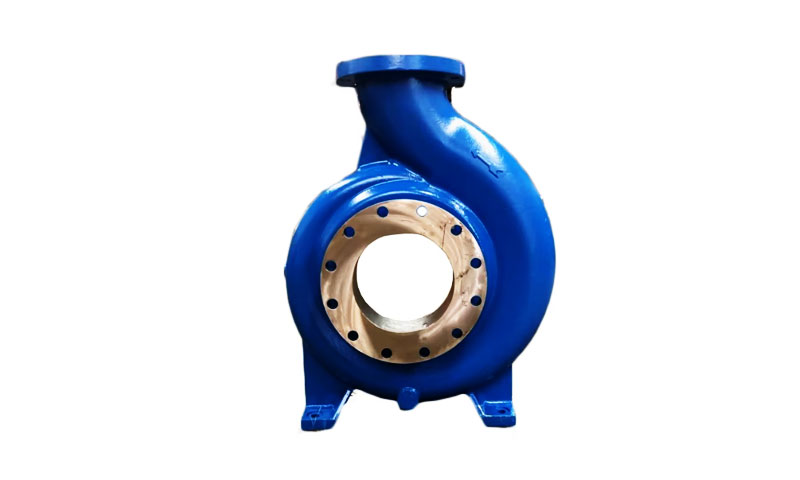1. Zavedenie
Pump bodies are structural and hydraulic housings that convert driver energy into fluid motion. They commonly contain volutes, impeller seats, bearing bosses, flanges and internal passages.
The manufacturing route chosen for a pump body sets achievable geometry, hutníctvo, cost and lead time.
Investment casting stands out where geometry is complex (internal guide vanes, thin webs, integrated bosses), tolerances are tight, and high-integrity alloys (nehrdzavejúce ocele, zliatiny niklu, bronz) sú potrebné.
2. What Is an Investment Casting Pump Body?
Definition and core functionality
A odlievanie investícií pump body is a pump housing produced by the lost-wax (investícia) metóda obsadenia.
A wax (alebo polymér) pattern of the pump body is created, coated in refractory ceramic to build a shell, the wax removed by heating, and molten metal poured into the ceramic mold.
The fired shell is broken away after solidification to reveal a near-net cast pump body that is subsequently finished and inspected.
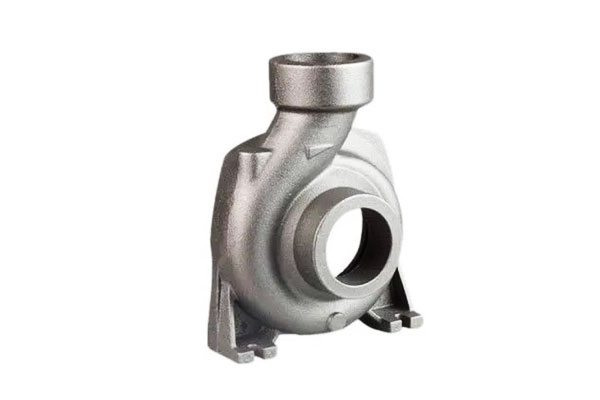
Typical specifications and dimensions
- Part mass: investment cast pump bodies usually range from a few hundred grams to tens of kilograms per piece; many foundries routinely cast pump bodies from ~0.5 kg up to ~50–100 kg depending on plant capability.
- Hrúbka steny: typical nominal walls for stainless or nickel alloys: 3–12 mm; minimum thin sections down to 1–2 mm are achievable in selected alloys and process control.
- Rozmerová tolerancia (ako cast): general investment cast tolerances commonly fall in ± 0,1–0,5 mm for small features; percent-based tolerance of ±0.25–0.5% linear is a practical rule of thumb.
Critical machined features are usually left with machining allowance (0.2–2.0 mm depending on casting accuracy). - Povrchová úprava (ako cast): typical Ra 1.6–3,2 μm (50–125 min) for standard ceramic shells; fine shells and careful pouring can produce Ra ≈ 0.8–1.6 μm.
Sealing faces or bearing journals are machined/lapped to much finer Ra (≤ 0.2 μm) as required.
3. Úvahy o návrhu
Investment casting enables complex geometry, but good design practice maximizes quality and minimizes cost.
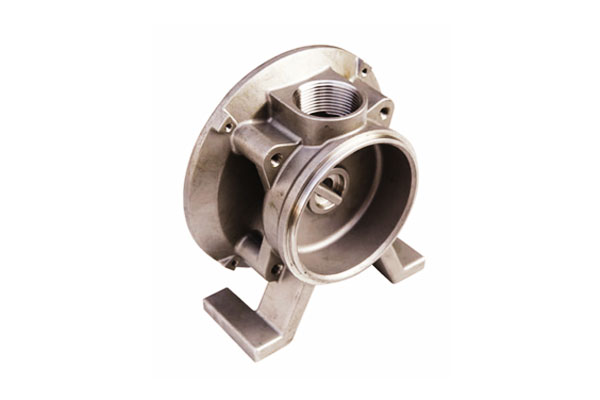
Hydraulic performance requirements
- Flow passages & volutes: smooth fillets and controlled convergence avoid separation and cavitation.
Internal fillet radii should be generous (≥ 1–2× wall thickness) to reduce turbulence. - Impeller seat alignment: concentricity and perpendicularity are critical — plan for machined bores and datum features.
- Clearances: pump clearances at impeller overhangs and seal faces must be maintainable by post-cast machining.
Structural requirements
- Stress & únava: consider cyclical loads; use finite-element analysis to identify local stress risers.
Cast metallurgy (veľkosť zrna, oddelenie) affects fatigue life—design to avoid thin, highly stressed bosses without proper filleting. - Vibration: stiff webs and ribs help raise natural frequencies; investment casting allows ribs to be integrated into the body.
Korózia & obliecť sa
- Výber materiálu: choose alloy based on fluid chemistry (pH, chloridy, erozívne častice, teplota).
For seawater, duplex or cupronickel may be required; for acids, Hastelloy or appropriate nickel alloys. - Erosion resistance: smooth internal surfaces and sacrificial coatings (tvrdý, tepelný sprej) are options where particulate slurry is present.
Rozmerové tolerancie & povrchová úprava
- Kritické vlastnosti: designate which faces/bores are finish-machined and specify machining allowances (Napr., 0.5–1.5 mm for sandier shells, 0.2–0.6 mm for precision shells).
- Sealing surfaces: specify Ra and flatness; often lapped/polished to Ra ≤ 0.2 μm and flatness within 0.01–0,05 mm depending on pressure class.
4. Materials for Investment Casting Pump Bodies
Material selection is a critical factor in designing and producing investment-cast pump bodies, as it directly affects mechanical performance, odpor, výroba, a životnosť.
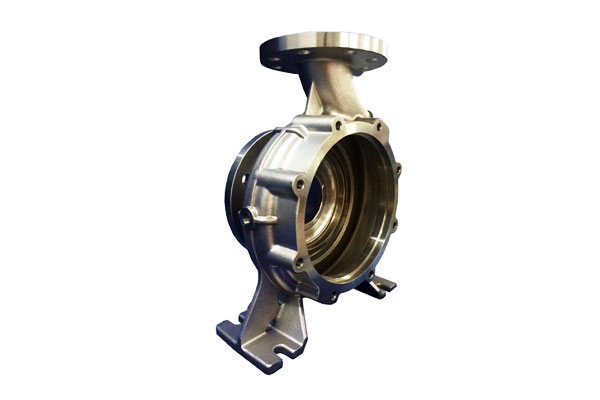
| Materiál | Príklad zliatin | Kľúčové vlastnosti | Typické aplikácie | Úvahy o obsadení |
| Austenitický Nerezová oceľ | 304, 316L | Vynikajúca odolnosť proti korózii, mierna sila, dobrú zvárateľnosť; Ťah: 480–620 MPA, Výnos: 170–300 MPA, Predĺženie: 40–60% | General chemical pumps, úpravy vody, jedlo & nápoj | Good molten fluidity, low hot-cracking risk, easy post-machining |
| Duplexná nehrdzavejúca oceľ | 2205, 2507 | Vysoká sila (Yield 450–550 MPa), superior chloride stress corrosion resistance | Marine and offshore pumps, agresívne chemické prostredie | Requires controlled temperature; post-casting heat treatment to prevent sigma phase |
Zliatiny niklu |
Odvoz 625, 718; Hastelloy | Výnimočná odolnosť proti korózii, vysoká teplota, oxidácia | Chemické spracovanie, generovanie energie, olej & plyn | High melting points (≈1450–1600 °C); careful mold preheating and controlled pouring needed; difficult machining |
| Bronz and Copper Alloys | C93200, C95400 | Vynikajúca odolnosť proti korózii morskej vody, dobrý odpor, antifouling; lower mechanical strength | Morské čerpadlá, chladenie morskej vody, hydraulické komponenty | Lower melting points (≈1050–1150 °C) simplify casting; low thermal cracking risk; mechanical strength lower than stainless/nickel |
5. Investment Casting Process for Pump Bodies
Odlievanie investícií, tiež známy ako obsadenie strateného vosku, enables the production of pump bodies with complex geometries, tenké steny, and high dimensional accuracy.
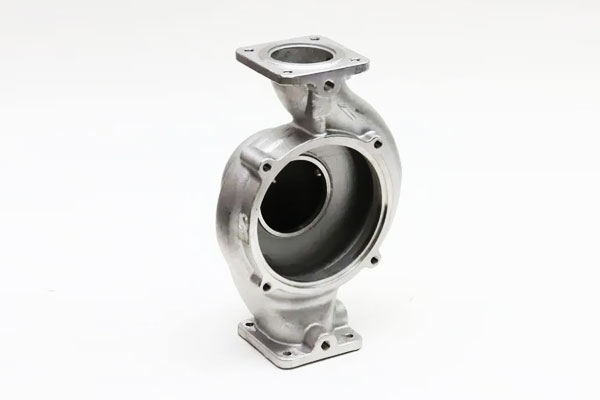
The process consists of several critical steps:
| Sťahovať | Popis | Kľúčové úvahy |
| 1. Tvorba vosku | Molten wax is injected into precision molds to form replicas of the pump body. | Ensure uniform wall thickness; maintain dimensional accuracy ±0.1 mm; use high-quality wax to prevent distortion. |
| 2. Assembly of Wax Tree | Individual wax patterns are attached to a central wax sprue to form a tree for batch casting. | Sprue design affects metal flow; minimize turbulence during pouring. |
| 3. Keramická škrupina | Repeated dipping in ceramic slurry and stuccoing with fine refractory sand creates a strong, rezistentná škrupina. | Target shell thickness (5–10 mm) depends on pump body size; avoid cracks and porosity in the shell. |
| 4. Dewaxing and Mold Firing | Wax is melted out (autoclave or kiln), opúšťanie dutiny; the ceramic shell is then fired to remove residues and strengthen the mold. | Temperature ramping must be controlled to prevent shell cracking; residual wax must be fully removed. |
5. Liatie kovu |
Roztavený kov (nehrdzavejúca oceľ, nickel alloy, alebo bronz) is poured into the preheated ceramic mold under gravity or vacuum-assisted conditions. | Pouring temperature and rate must ensure complete filling; control turbulence and prevent oxide formation. |
| 6. Solidifikácia a chladenie | Metal solidifies inside the mold; cooling rates affect microstructure, mechanické vlastnosti, a zvyškový stres. | Thick sections may require controlled cooling to prevent porosity; thin walls must avoid hot tearing. |
| 7. Odstránenie škrupiny | Ceramic shell is broken away mechanically, often using vibration, sand blasting, or chemical dissolution. | Avoid damaging intricate pump channels or flanges. |
| 8. Finishing and Cleaning | Residual ceramic, gating system, and surface imperfections are removed via grinding, otryskanie, or chemical cleaning. | Maintain dimensional tolerances; prepare surfaces for subsequent machining or coating. |
6. Operácie po preliatí
After the pump body is removed from the ceramic shell, several post-casting operations are performed to ensure the component meets functional, rozmerový, a požiadavky na kvalitu povrchu.
These operations are critical for high-performance applications in chemical, námorný, a priemyselné sektory.
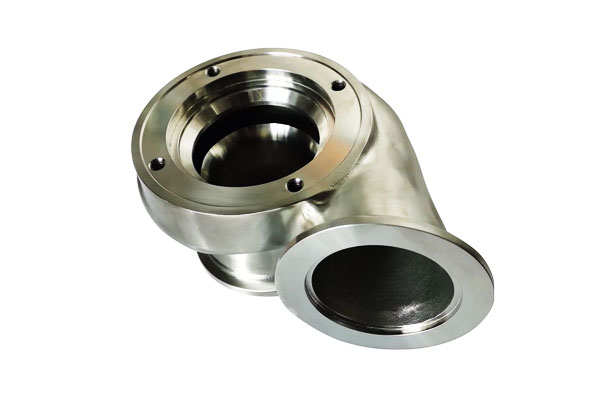
Tepelné spracovanie
Tepelné spracovanie is applied to relieve residual stresses, zlepšiť ťažnosť, and optimize mechanical properties:
- Žíhanie stresu: Heating to 550–650 °C for stainless steels reduces residual stress from casting and prevents distortion during machining.
- Žíhanie riešenia: Applied for stainless steels and nickel alloys to homogenize microstructure and dissolve unwanted precipitates, ensuring corrosion resistance and consistent hardness.
- Aging or Precipitation Hardening (for certain alloys): Enhances strength and wear resistance in high-performance materials.
Obrábanie
Critical dimensions such as flanges, vŕtačka, mating surfaces, and threaded ports are machined to meet tight tolerances.
Typical machining operations include turning, mletie, vŕtanie, and boring. Machining ensures:
- Dimensional tolerances of ±0.05–0.1 mm for precise assembly.
- Smooth sealing surfaces to prevent leaks in high-pressure applications.
Povrchová úprava
Povrchová úprava Zvyšuje odolnosť proti korózii, odpor, a estetiku:
- Leštenie: Improves smoothness for sealing faces and internal channels.
- Otryskanie: Removes residual ceramic particles and creates a uniform surface for coating or painting.
- Povlaky: Optional chemical or electroplated coatings (Napr., nikel, Ptfe) enhance corrosion resistance and reduce friction.
Nedeštruktívne testovanie (Ndt)
To detect defects such as porosity, prasklina, or inclusions, NDT is performed:
- Rádiografia (Röntgen): Identifies internal voids and inclusions.
- Ultrazvukové testovanie (Ut): Detects subsurface flaws in thick sections.
- Testovanie prenikajúcich farbív (Pt): Reveals surface cracks and porosity.
Cleaning and Inspection
Konečne, pump bodies are cleaned to remove residual machining oils, Trosky, or salts. Dimensional and visual inspections verify compliance with specifications before assembly or shipment.
7. Quality Assurance and Testing
Zabezpečenie kvality (QA) is critical in ensuring that investment casting pump bodies meet design specifications, performance standards, a priemyselné požiadavky.
A systematic QA approach combines dimensional checks, mechanické testovanie, and non-destructive evaluation to detect defects and confirm functional integrity.
Rozmerová kontrola
Dimensional verification ensures that the pump body conforms to design drawings and tolerances:
- Koordinovať meracie stroje (Cmm): Measure complex geometries, vŕtačka, príruba, and mounting surfaces with accuracy of ±0.01–0.05 mm.
- Gauge Tools: Thread gauges, plug gauges, and height gauges verify critical features quickly in production.
- Meranie drsnosti povrchu: Confirms finishing requirements for sealing faces and internal channels (Napr., Ra ≤0.8 μm for hydraulic components).
Mechanical Property Verification
Mechanical testing validates that the material meets required strength, ťažkosť, a tvrdosť:
- Testovanie v ťahu: Measures yield strength, ultimate tensile strength, a predĺženie, ensuring the material can withstand operational loads.
- Testovanie tvrdosti: Rockwell or Vickers testing confirms that heat treatment and material processing achieved the desired hardness.
- Testovanie dopadu (Ak sa to vyžaduje): Evaluates toughness for applications exposed to fluctuating loads or shock.
Nedeštruktívne testovanie (Ndt)
NDT techniques detect hidden defects without damaging the part:
- Rádiografia (X-ray/CT Scanning): Identifies internal porosity, inklúzia, and voids, particularly in thick sections.
- Ultrazvukové testovanie (Ut): Detects internal cracks, medzery, or delaminations in dense materials like stainless steel and nickel alloys.
- Testovanie prenikajúcich farbív (Pt): Reveals surface cracks, pinty, or fine porosity not visible to the naked eye.
- Testovanie magnetických častíc (Mt): Applied for ferromagnetic alloys to detect surface and near-surface discontinuities.
Common Casting Defects and Mitigation Strategies
- Pórovitosť: Minimized through proper gating, odvzdušnenie, and controlled solidification rates.
- Dutiny: Addressed via riser design and thermal management.
- Studené zatvorené a nesprávne: Avoided by maintaining optimal pouring temperatures and smooth flow in complex geometries.
- Surface Inclusions: Controlled by using high-purity alloys and proper degassing techniques.
8. Advantages of Investment Casting for Pump Bodies
- Komplexná geometria: vnútorné pasáže, thin walls and integrated bosses with minimal secondary assembly.
- Tvar: reduces material removal vs. rough machining from bar or billet — often 30–70% less machining Pre komplexné diely.
- Vysoká dimenzionálna presnosť & povrchová úprava: less secondary finishing for many features compared with sand casting.
- Alloy flexibility: cast many stainless and nickel alloys with good metallurgical integrity.
- Small to medium production flexibility: tooling for wax patterns is relatively inexpensive vs. large die tooling, enabling economic runs from prototypes to thousands of parts.
9. Obmedzenia a výzvy
- Cost for very large parts: above certain sizes (často >100 kg) investment casting becomes uneconomical compared with sand casting or fabricating/ welding.
- Dodací čas: pattern tooling, shell building and firing add lead time—prototype timelines usually measured in weeks.
- Porosity risk in thick sections: thick bosses or large cross-sections require careful gating, chills or segmenting to avoid shrinkage.
- Surface finish and tolerances depend on shell system: achieving ultra-fine finishes or extremely tight as-cast tolerances requires premium ceramic systems and process control.
10. Priemyselné aplikácie
Investment casting pump bodies are used across a broad spectrum of industries due to their complex geometry capabilities, všestrannosť, and high dimensional accuracy.
The process allows engineers to design optimized hydraulic passages, tenké steny, and integrated mounting features that improve pump efficiency and longevity.
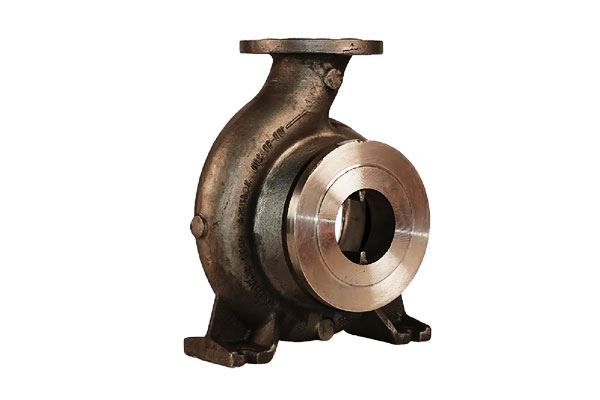
Chemical Processing Pumps
- Prostredie: Corrosive fluids such as acids, caustics, a rozpúšťadlá.
- Materials Used: Nehrdzavejúce ocele (316L, duplexný) and nickel alloys (Hastelloy, Odvoz).
- Odôvodnenie: Investment casting enables intricate internal channels, minimizing turbulence and ensuring uniform flow, critical for chemical process reliability.
Water and Wastewater Pumps
- Prostredie: High-volume pumping, abrasive suspended solids, and variable pH levels.
- Materials Used: Bronz, duplexná nehrdzavejúca oceľ, and corrosion-resistant cast irons.
- Odôvodnenie: Thin-wall, smooth internal passages reduce clogging and energy losses, improving efficiency in municipal and industrial water systems.
Marine and Offshore Pumps
- Prostredie: Saltwater exposure, high-pressure operation, and cyclical mechanical stress.
- Materials Used: Zliatiny medi (námorná mosadz, bronz), duplexné nehrdzavejúce ocele.
- Odôvodnenie: Resistance to corrosion and biofouling is critical; investment casting allows seamless, complex geometries to reduce maintenance and improve service life.
Olej & Gas and Power Generation Pumps
- Prostredie: Vysoká teplota, high-pressure fluids, and hydrocarbon-based media.
- Materials Used: High-nickel alloys (Odvoz, Hastelloy), nehrdzavejúca oceľ, and cobalt-based alloys.
- Odôvodnenie: Investment casting supports high-strength materials and precise tolerances necessary for critical applications such as turbine lubrication, chemical injection, and offshore drilling.
Specialty and Custom Pumps
- Prostredie: Laboratory, farmaceutický, or food processing applications requiring hygienic and precision performance.
- Materials Used: Nehrdzavejúca oceľ (304, 316L), titán, alebo niklová zliatiny.
- Odôvodnenie: Hladké povrchy, tesné tolerancie, and complex geometries achieved by investment casting ensure minimal contamination risk and compliance with regulatory standards.
11. Porovnávacia analýza
| Funkcia / Kritériá | Investičný casting | Odlievanie piesku | Machining from Solid |
| Geometrická zložitosť | Excellent – thin walls, interné kanály, intricate features achievable | Moderate – limited by core placement and mold stability | Limited – complex internal geometries often impossible without assembly |
| Rozmerová presnosť | High – ±0.1–0.25 mm typical | Moderate – ±0.5–1.0 mm | Very High – ±0.05 mm achievable |
| Povrchová úprava (Rana) | Fine – 1.6–3.2 μm typical; can be polished | Rough – 6–12 μm; requires machining for precision | Excellent – 0.8–1.6 μm achievable with finishing |
| Materiálne možnosti | Wide – stainless steels, zliatiny niklu, bronz, zliatiny medi | Wide – iron, oceľ, bronz, hliník | Wide – depends on machinable stock availability |
| Šarža | Low-to-medium – 1–1000+ parts | Medium-to-high – economical for large, jednoduché diely | Low – material waste increases cost for large parts |
| Dodací čas | Moderate – wax pattern & shell building required | Short-to-moderate – mold preparation relatively quick | Variable – depends on machining complexity |
Odpadový odpad |
Low – near-net shape reduces scrap | Moderate – gating and risers generate some waste | High – subtractive process creates chips and offcuts |
| Cena na časť | Moderate-to-high – tooling and process steps increase cost, economical for complex parts | Low-to-moderate – simpler molds, larger parts cheaper | High – extensive machining on large, complex parts is expensive |
| Pevnosť & Integrita | Excellent – dense microstructure, minimal porosity if controlled | Moderate – risk of sand-related inclusions and porosity | Excellent – homogeneous, Žiadne defekty obsadenia |
| Post-Processing Required | Often minimal – some machining, dokončenie | Usually significant – machining and finishing required | Minimal – final finishing for tight tolerances only |
| Typické aplikácie | Pump bodies with thin walls, complex hydraulic channels, odpor | Veľký, simple pump housings or structural components | Custom or prototype pump bodies requiring extreme precision |
12. Záver
Investment casting pump body combines design freedom with metallurgical integrity, making them an excellent choice for many fluid-handling applications—especially where complex internal geometry, exotic alloys or tight tolerances are required.
Success depends on early design for casting, informed material selection, careful process control (nalievanie, shelling, tepelné spracovanie), and robust QA/NDT programs.
For critical pump systems—marine, chemical or power generation—investment casting can deliver reliable, economical components when specified and executed correctly.
Časté otázky
What maximum size of pump body can be investment cast?
Typical shop practice ranges up to ~50–100 kg per part, but the practical maximum depends on foundry capability and economics.
Very large pump bodies are more often produced by sand casting or fabricating/welding.
How much machining allowance should I design into an investment casting?
Povoliť 0.2–2,0 mm depending on the criticality and shell precision. Specify tighter allowances only where the foundry guarantees precision shells.
Which material is best for seawater pump bodies?
Duplex stainless steels and selected copper-nickel alloys are common choices due to superior chloride pitting resistance and biofouling performance; final selection depends on temperature, velocity and erosion conditions.
What is the typical turnaround time for an investment-cast pump body?
Small production runs typically take 4–8 týždňov from pattern approval to finished parts; single prototypes can be faster with 3D-printed patterns but still require shell firing and melt schedules.
How do I specify acceptance criteria for porosity?
Use industry NDT standards (rádiografia, Ct, Ut) and define acceptance levels in percent porosity by volume or via reference images.
Critical pressure-retaining pump bodies often require porosity <0.5% by volume and radiographic acceptance per customer standard.
